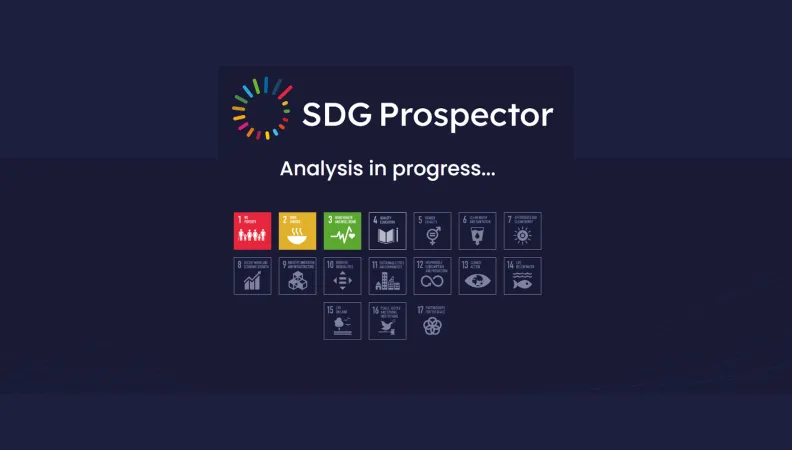Share the page
SDG Prospector – Mobilizing artificial intelligence to achieve the 2030 Agenda

-
Project start date
-
2021Status
Completed
-
AFD financing amount
-
60000
-
Country and region
-
Location
-
Multi-country
-
Research program
Faced with major social and environmental transitions, an increasing number of companies and institutions are called upon to account for the extra-financial impacts of their activities. The SDG Prospector applies artificial intelligence (AI) methods to map the alignment of public development banks (PDBs) to the 17 Sustainable Development Goals (SDGs). An innovative solution to better understand the role of PDBs in sustainable finance.
Context
522 is the number of public development banks identified to date (Xu et al, 2021) that make up the Finance in Common global coalition. Responsible for around 10% of the world’s annual investment, these institutions play an essential role in the international financial architecture. With a mandate and public responsibility, they provide financial support in sectors where social and/or environmental profitability is greater than private profitability, such as health, education and the fight against climate change. Thus, they are called to play a decisive role in achieving the 2030 Agenda.
Some public development banks (PDBs) analyse their alignment with the SDGs, but the use of disparate methods does not yield reliable and comparable results. At the same time, the majority of PDBs publish an annual activity and sustainable development report. These documents, available online, are a wealth of information today little exploited and on which we rely in our project.
Goal
This research project led by AFD aims to test the potential of artificial intelligence (AI) technologies for the benefit of sustainable development. It resulted in the creation of the SDG Prospector, a tool that offers a unified and relevant method to map the extra-financial commitments of public development banks. It quantifies the degree of importance given to each of the 17 Sustainable Development Goals in official PDBs documentation.
The analysis was conducted over a five-year period (2016-2020) for 237 institutions. Thus, it is possible to draw up an overview of the SDG alignment by bank, geographies, size of balance sheets, mandates, levels of development, etc.
Read also: Using Artificial Intelligence to assess progress towards the Sustainable Development Goals
Method
In order to extract the information contained in the annual reports of public development banks, the SDG Prospector applies an artificial intelligence method specialized in language analysis (Natural Language Processing). This innovative technique is more accurate than a keyword analysis, as it allows the tool to recognize the context of sentences.
To do this, the SDG Prospector relies on a learning base, which allows it to identify when a text mentions the SDGs and to determine which SDG it is. The learning base consists of more than 8,500 texts related to the 2030 Agenda, mainly from United Nations documents, government reports and NGOs. Specializing in the recognition of SDGs, the Prospector divides each annual report into paragraphs of about ten lines and determines whether there is mention of one, several or no SDGs.
Results
The results allow to draw an extensive mapping of PDBs’ positioning towards the 2030 Agenda:
- PDBs strategic and operational narrative is mainly structured around the SDGs, such as SDG 8 “Decent Work and Economic Growth” and SDG 9 “Innovation and Infrastructure”;
- SDG 13 “Climate Action” is increasingly taken into account by the entire sample, and we note a positive correlation between the size of PDBs’ balance sheet and their consideration for SDGs that are associated with environmental protection;
- Biodiversity constitutes a negligible part of PDBs’ narrative;
- Social SDGs account for 21% of PDBs’ annual reports. However, cross-cutting SDGs such as gender equality, reduced inequalities and the eradication of poverty represent a minor share of PDBs’ narrative;
- PDBs that have similar characteristics in terms of size, mandate and geography tend to share the same SDG narrative.
Analyze your document with the SDG Prospector: sdgprospector.org
Lessons learned
The artificial intelligence techniques used allow new data to emerge, both for research and for the operational implementation of the SDGs. Other innovative projects followed by AFD contribute to this dynamic, in line with the IA-Biodiv Challenge.
Read our Research Paper: "The Proof is in the Pudding: Revealing the SDGs with Artificial Intelligence"
Contact:
- Régis Marodon, Special Advisor on sustainable finance at AFD
- Jean-Baptiste Jacouton, Research Officer at AFD
